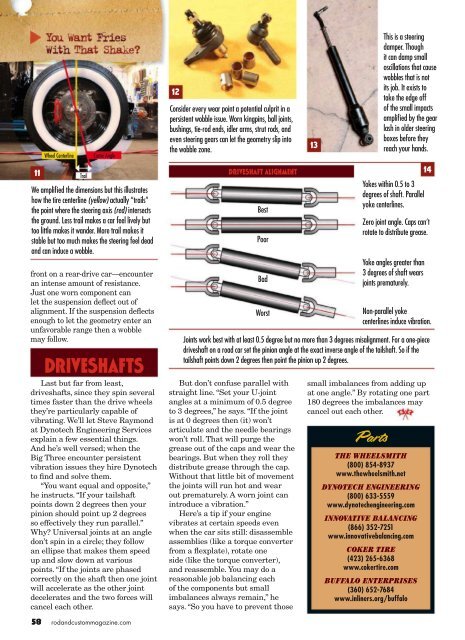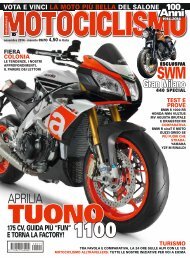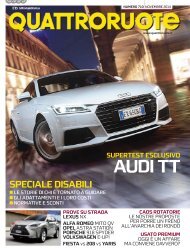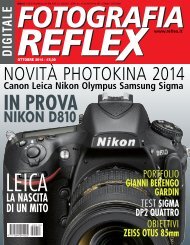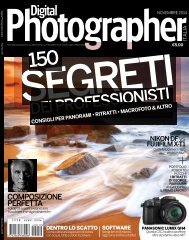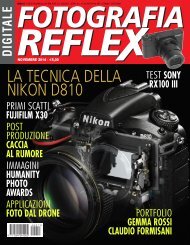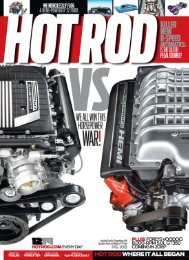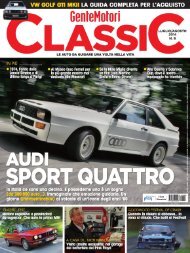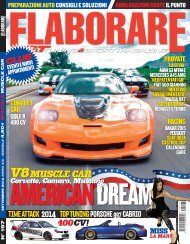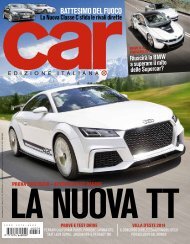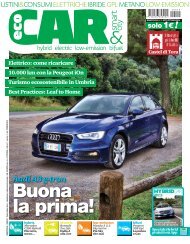You also want an ePaper? Increase the reach of your titles
YUMPU automatically turns print PDFs into web optimized ePapers that Google loves.
11<br />
Wheel Centerline<br />
Trail<br />
Caster Angle<br />
We amplified the dimensions but this illustrates<br />
how the tire centerline (yellow) actually “trails”<br />
the point where the steering axis (red) intersects<br />
the ground. Less trail makes a car feel lively but<br />
too little makes it wander. More trail makes it<br />
stable but too much makes the steering feel dead<br />
and can induce a wobble.<br />
front on a rear-drive car—encounter<br />
an intense amount of resistance.<br />
Just one worn component can<br />
let the suspension deflect out of<br />
alignment. If the suspension deflects<br />
enough to let the geometry enter an<br />
unfavorable range then a wobble<br />
may follow.<br />
DRIVESHAFTS<br />
Last but far from least,<br />
driveshafts, since they spin several<br />
times faster than the drive wheels<br />
they’re particularly capable of<br />
vibrating. We’ll let Steve Raymond<br />
at Dynotech Engineering Services<br />
explain a few essential things.<br />
And he’s well versed; when the<br />
Big Three encounter persistent<br />
vibration issues they hire Dynotech<br />
to find and solve them.<br />
“You want equal and opposite,”<br />
he instructs. “If your tailshaft<br />
points down 2 degrees then your<br />
pinion should point up 2 degrees<br />
so effectively they run parallel.”<br />
Why? Universal joints at an angle<br />
don’t spin in a circle; they follow<br />
an ellipse that makes them speed<br />
up and slow down at various<br />
points. “If the joints are phased<br />
correctly on the shaft then one joint<br />
will accelerate as the other joint<br />
decelerates and the two forces will<br />
cancel each other.<br />
12<br />
Consider every wear point a potential culprit in a<br />
persistent wobble issue. Worn kingpins, ball joints,<br />
bushings, tie-rod ends, idler arms, strut rods, and<br />
even steering gears can let the geometry slip into<br />
the wobble zone.<br />
DRIVESHAFT ALIGNMENT<br />
Best<br />
Poor<br />
Bad<br />
Worst<br />
But don’t confuse parallel with<br />
straight line. “Set your U-joint<br />
angles at a minimum of 0.5 degree<br />
to 3 degrees,” he says. “If the joint<br />
is at 0 degrees then (it) won’t<br />
articulate and the needle bearings<br />
won’t roll. That will purge the<br />
grease out of the caps and wear the<br />
bearings. But when they roll they<br />
distribute grease through the cap.<br />
Without that little bit of movement<br />
the joints will run hot and wear<br />
out prematurely. A worn joint can<br />
introduce a vibration.”<br />
Here’s a tip if your engine<br />
vibrates at certain speeds even<br />
when the car sits still: disassemble<br />
assemblies (like a torque converter<br />
from a flexplate), rotate one<br />
side (like the torque converter),<br />
and reassemble. You may do a<br />
reasonable job balancing each<br />
of the components but small<br />
imbalances always remain,” he<br />
says. “So you have to prevent those<br />
13<br />
Parts<br />
THE WHEELSMITH<br />
(800) 854-8937<br />
www.thewheelsmith.net<br />
This is a steering<br />
damper. Though<br />
it can damp small<br />
oscillations that cause<br />
wobbles that is not<br />
its job. It exists to<br />
take the edge off<br />
of the small impacts<br />
amplified by the gear<br />
lash in older steering<br />
boxes before they<br />
reach your hands.<br />
Yokes within 0.5 to 3<br />
degrees of shaft. Parallel<br />
yoke centerlines.<br />
Zero joint angle. Caps can’t<br />
rotate to distribute grease.<br />
Yoke angles greater than<br />
3 degrees of shaft wears<br />
joints prematurely.<br />
Non-parallel yoke<br />
centerlines induce vibration.<br />
Joints work best with at least 0.5 degree but no more than 3 degrees misalignment. For a one-piece<br />
driveshaft on a road car set the pinion angle at the exact inverse angle of the tailshaft. So if the<br />
tailshaft points down 2 degrees then point the pinion up 2 degrees.<br />
DYNOTECH ENGINEERING<br />
(800) 633-5559<br />
www.dynotechengineering.com<br />
INNOVATIVE BALANCING<br />
(866) 352-7251<br />
www.innovativebalancing.com<br />
COKER TIRE<br />
(423) 265-6368<br />
www.cokertire.com<br />
BUFFALO ENTERPRISES<br />
(360) 652-7684<br />
www.inliners.org/buffalo<br />
14<br />
small imbalances from adding up<br />
at one angle.” By rotating one part<br />
180 degrees the imbalances may<br />
cancel out each other.<br />
58 rodandcustommagazine.com


